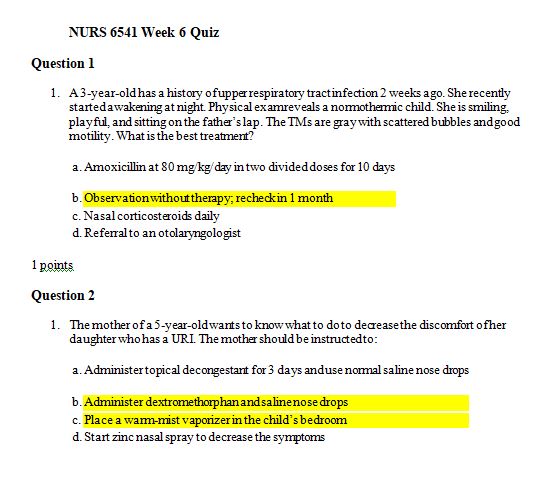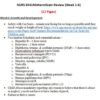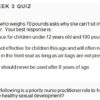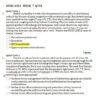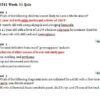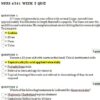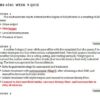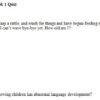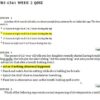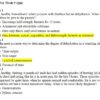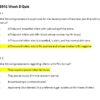Description
NURS 6541 Week 6 Quiz 1 – Question and Answers
- A 65-year-old male recently had a cerebrovascular accident that resulted in dysphagia. He now has aspiration of gastric contents. The nurse assesses the patient for which complication?
- A nurse is preparing to teach the staff about asthma. Which information should the nurse include? Airway obstruction contributing to increased airflow resistance and hypoventilation in asthma is caused by:
- A 50-year-old male presents with hypotension, hypoxemia, and tracheal deviation to the left. Tests reveal that the air pressure in the pleural cavity exceeds barometric pressure in the atmosphere. Based upon these assessment findings, what does the nurse suspect the patient is experiencing?
- A 45-year-old male undergoes lung transplantation. He now suffers from airway occlusion secondary to fibrosis. Which diagnosis will the nurse see on the chart?
- hen the nurse is asked what causes asthma, how should the nurse respond? Asthma is thought to be caused by:
- 25-year-old male presents with chronic bronchitis of 5 months’ duration. When obtaining the patient’s history, which of the following findings is most likely to cause this condition?
- A 22-year-old female presents with chronic bronchitis. Tests reveal closure of the airway during expiration. While planning care, a nurse recalls this condition is most likely cause by:
- Individuals with a recent diagnosis of emphysema should be assessed for which most common presenting factor?
- A 28-year-old male reports to his primary care provider that he has had a cold for a week and is coughing up bloody secretions. When giving report, what term should the nurse use to describe this condition?
- A nurse recalls asthma is classiy by:
- While planning care for a child with asthma, which of the following is characteristic of asthma?
- A nurse is preparing to teach the staff about asthma. Which information should the nurse include? Airway hyper-responsiveness in asthma is ……:
- A 47-year-old male is diagnosed with pulmonary edema. Which assessment findings will the nurse observe? nurs 6541 week 6 quiz
- A nurse is teaching staff about pulmonary edema. Which information should the nurse include? The most common cause of pulmonary edema is:
- A 7-month-old male presents with cystic fibrosis (CF) accompanied by failure to thrive and frequent, loose, and oily stools. Sweat testing reveals increased chloride. Which of the following should the nurse observe for that would accompany this disease?
- A geneticist is discussing cystic fibrosis (CF). Which information should be includ? CF is an _____ disease.
- A 10-year-old male is brought to the ER with prolonged bronchospasm and severe hypoxemia. The most likely diagnosis on the chart is:
- A 50-year-old diabetic male did not take his medication and is now in metabolic acidosis. He is experiencing Kussmaul respirations. What type of breathing will the nurse observe upon assessment?
- A 60-year-old female with a 25-year history of smoking is diagnosed with emphysema. She has an increase anterior-posterior chest diameter. The nurse attributes this finding to:
- A 57-year-old male presents with cough, sputum production, dyspnea, and decreased lung volume. He is diagnose with pneumoconiosis. When taking the patient’s history, which finding is the most probable cause of his illness?
- Which of the following shows a correct cause and effect sequence in the development of acute respiratory distress syndrome (ARDS)?
- A 53-year-old male with a 20-year history of smoking is diagnose with emphysema. When a staff member asks why the patient’s airways are …., how should the nurse respond? The airways are obstruct because of:
- A 13-year-old female is diagnose with asthma. Which of the following should the nurse teach the patient to recognize as part of an asthmatic attack? nurs 6541 week 6 quiz
- A 10-year-old female develops pneumonia. Physical exam reveals subcostal and intercostal retractions. She reports that breathing is difficult and she feels she cannot get enough air. What term should the nurse use to document this condition?
- An 11-year-old female presents with a low-grade fever and cough. She is diagnose with atypical pneumonia. What type of pneumonia does the nurse suspect the patient is experiencing?
- An 80-year-old female develops pneumonia in the hospital. She becomes cyanotic, tachycardic, and develops a fever and cough. Chest x-ray reveals pus in the pleural space. Which of the following is the most likely diagnosis document on the chart?
- If an individual with respiratory difficulty were retaining too much carbon dioxide, which of the following compensatory responses would the nurse expect to be initiated?
- A 20-year-old male is in acute pain. An arterial blood gas reveals decreased carbon dioxide (CO2) levels. Which of the following does the nurse suspect is the most likely cause?
- When the pulmonologist discusses the condition in which a series of alveoli in the left lower lobe receive adequate ventilation but do not have adequate perfusion, which statement indicates the nurse understands this condition? When-this occurs in a patient it is…..
- When the nurse observes a diagnosis of nosocomial pneumonia, the patient generally acquires this pneumonia:

